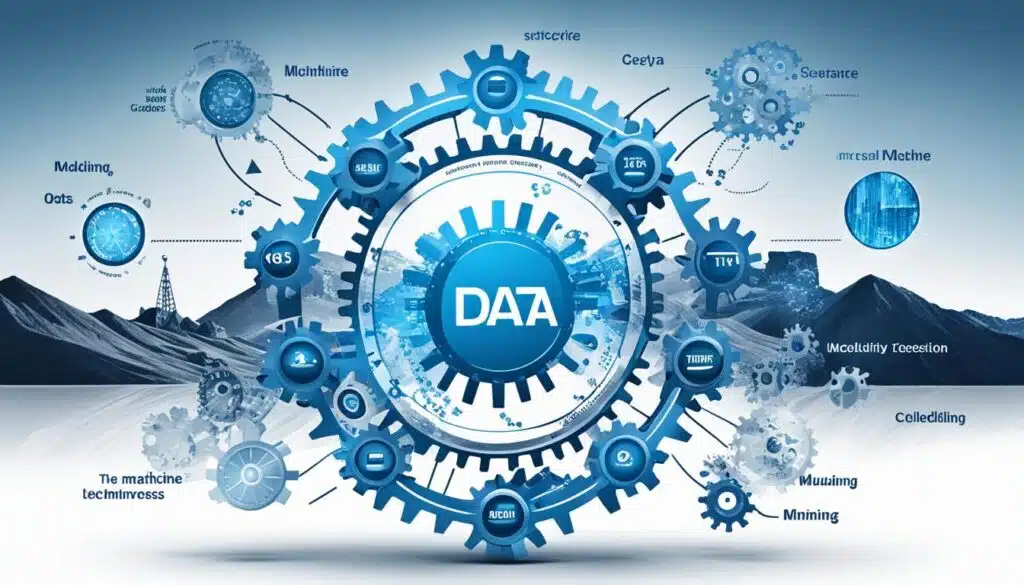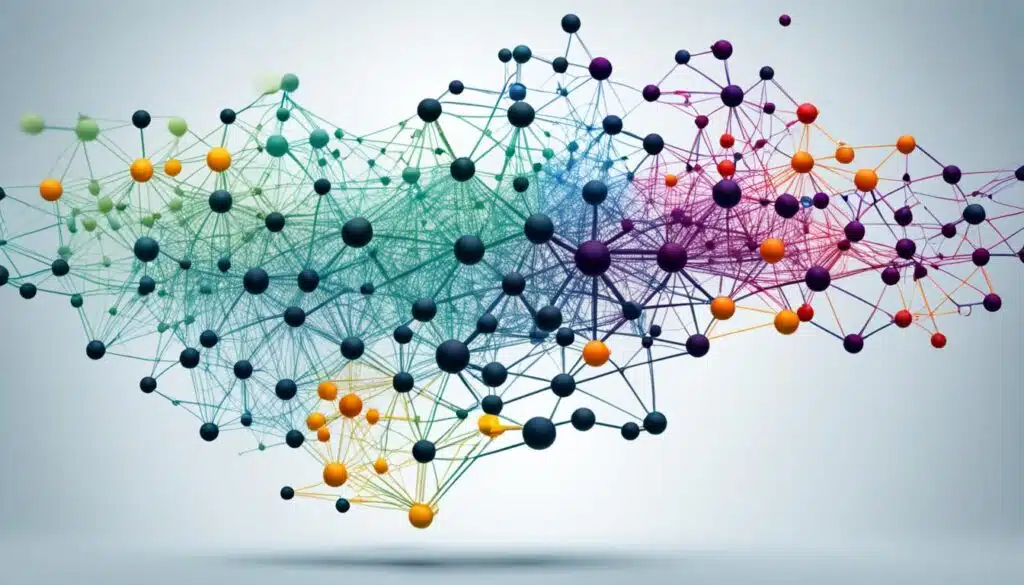Data mining finds patterns in large amounts of data. It helps companies know more about their customers. With this knowledge, companies can make better marketing strategies, increase sales, and lower their costs.
Data mining is possible because of good data collection and computer work. It’s an essential tool for modern businesses.
Key Takeaways
- Data mining helps companies analyze large volumes of data to identify patterns and extract valuable insights.
- Companies can use data mining to develop more effective marketing strategies, increase sales, and reduce costs.
- Effective data collection, warehousing, and computer processing are essential for successful data mining.
- Data mining can be applied in various industries, including sales, marketing, manufacturing, and fraud detection.
- The benefits of data mining include cost-effective solutions, reliable insights, quantifiable results, and improved strategy development.
Introduction to Data Mining
Data mining is vital today. It involves searching for patterns in large data sets. This search helps uncover valuable insights. These insights can guide important decisions in business and other fields. Data mining is changing how organizations use the huge amounts of data they collect.
Definition of Data Mining
Data mining aims to pull out useful info from big, complicated data sets. It uses special algorithms and methods to do this. By spotting trends and unique finds, data miners can make powerful suggestions. These suggestions are based on what the data shows.
History of Data Mining
In the 1960s, statisticians and computer scientists first looked into data mining. They wanted to find new ways to analyze large amounts of data. As technology improved, so did data mining. Today, we have advanced data mining techniques and tools.
Now, data mining is key in data analytics and working with big data. It helps companies in many fields. They use data mining to innovate, make better choices, and stand out from competitors.
The Data Mining Process

Data analysts have a set process they follow to get the best results. This process has several steps to break it down. The steps help them move from start to finish effectively.
Understanding the Business
The journey starts by understanding the businesses’ needs. This means knowing the goals and challenges the company faces. It’s about learning what’s important and what will help the company succeed.
Understanding the Data
Next, they dive into the available data. They find where the data comes from and what’s important. Knowing the quality and amount of data is crucial for their work.
Preparing the Data
After gathering data, it needs prepping. This includes cleaning it up and organizing it. These steps are vital to make sure the data is ready for deep analysis.
Modeling the Data
With clean data, analysts then create models. Models are like maps to find patterns in the information. They use different methods to make these models work well.
Evaluating the Results
Then, they check how well their models work. This step is key in knowing if the model is accurate. They look at the model’s strengths and where it might need improvements.
Deploying the Solution
Finally, it’s about putting their findings to work. This involves using the model in real business situations. They make sure it helps the company as expected.
| Step | Description |
|---|---|
| Understanding the Business | Gather information about the company, its industry, and the specific challenges it faces. Define the business objectives and the types of insights that will be most valuable. |
| Understanding the Data | Explore the data sources, identify the relevant data points, and assess the quality and completeness of the data. Determine the most appropriate data mining techniques to use. |
| Preparing the Data | Clean, transform, and integrate the data from multiple sources. Ensure that the data is in a format that can be effectively processed and analyzed using data mining software and tools. |
| Modeling the Data | Build a model that can identify patterns and relationships in the data. Experiment with different models and techniques to find the one that best fits the business objectives. |
| Evaluating the Results | Assess the accuracy and reliability of the model, and its ability to provide meaningful insights that can be used to drive business decisions. Consider the potential limitations and biases of the model and adjust it accordingly. |
| Deploying the Solution | Integrate the model into the company’s data analytics infrastructure, train employees to use the model, and monitor the model’s performance over time. Ensure that the solution is meeting the company’s business objectives and delivering the expected ROI. |
Data Mining Techniques

Data mining uses many algorithms to turn big data into useful information. It helps make sense of vast amounts of data. Some key data mining techniques are:
Classification
In classification, data gets sorted into groups or classes. This is based on shared features. It’s handy for spotting trends in things like customer types or spotting fraud.
Clustering
Clustering groups similar data together without labels. It uncovers hidden patterns. This is useful in understanding customer behavior, market groups, and finding anomalies.
Association Rules
Association rule mining finds links between items in a dataset. It’s used to see shopping habits in market basket analysis. This leads to better product bundles and marketing.
Regression Analysis
Regression analysis looks at how dependent and independent variables relate. It’s great for predicting the future, demand, and managing risks. It’s a powerful forecasting tool.
Anomaly and Outlier Detection
Spotting anomalies and outliers finds the odd data points. This technique is key in finding fraud, errors, or other problems. It’s a crucial part of making big data more secure and reliable.
Data mining offers many tools for learning from data. Businesses use these tools to make smart choices. By applying data mining with big data and deep analytics, companies can stand out and find new ways to improve and grow.
Choosing the right data mining techniques depends on what a business wants to achieve. It’s a team effort for data scientists to pick which tools work best. They aim to pull insights from complex, vast data sets.
Applications of Data Mining

Today, every sector relies on data mining. It aids in various tasks, from boosting sales to preventing fraud. By using data analytics and big data, companies gain insights. These help in making smarter decisions and improving their operations.
Sales and Marketing
Data mining is key in sales and marketing. It helps companies spend money wisely to increase sales. Businesses look at customer data to figure out effective marketing. They learn where to place ads and which strategies attract people the most. This leads to better sales and keeps customers coming back.
Manufacturing
In manufacturing, data mining improves production and quality. Companies use data to spot patterns and predict problems. This helps them make choices based on evidence, cutting down on waste. It makes them more efficient and stands out in the market.
Fraud Detection
Data mining is a strong weapon against fraud. It sifts through data to find fishy activities. By noticing suspicious actions early, companies protect themselves from financial harm. They keep their names clean and operations secured.
Risk Management
Data mining is pivotal in managing risks. It looks at tons of data to spot trends and upcoming dangers. With these insights, companies prepare ahead to face risks better. It lets them steer clear of threats and stay resilient.
Benefits of Data Mining

Data mining helps businesses in many ways. It uses data analytics and big data. The advantages include cost-effective solutions and reliable insights. It also offers quantifiable results and chances for strategic growth.
Cost-Effective Solution
Data mining is a smart way to understand customers and find new income. It helps businesses cut costs and make more money. They do this without spending a lot on new things or hiring more people.
Reliable Insights
Businesses get reliable insights from large amounts of data through data mining. This helps with planning, making products, and marketing. It makes the companies understand their customers, the market, and their rivals better.
Quantifiable Results
The data mining process gives results that can be measured over time. By using data mining tools, businesses check the effects of their choices. They improve their strategies and show the worth of their data work.
Strategy Development
Effective data mining aids strategy making. It helps find patterns in large data sets and predict market trends. With these insights, companies can make choices that fit their goals. This leads to better and more successful plans.
Also Read : The Role Of Internet Of Things In Smart Homes and Cities
Data Mining Tools and Software
The world of data mining is growing fast. New tools and software are born to make things easier. They help organizations sift through big data, finding important information for smart choices.
Python is a star among these tools. It’s a powerful language with lots of resources for data analysis. Tools like Pandas, NumPy, and Scikit-learn are beloved by data scientists. They make handling and understanding data smoother, key in any data mining project.
R is another big name. It’s completely free and built for stats and graphics. With packages like ggplot2 for visualizing data and caret for predictions, R stands out. Many organizations rely on it to solve complex data issues because of its strong user community.
For big data missions, Apache Hadoop and Apache Spark are crucial. They let multiple computers work together on massive sets of data. This way, handling huge amounts of information becomes easier. Cloud services like Amazon Web Services (AWS) Athena and Google Cloud BigQuery offer more options. They let organizations scale up their data capacity without a big jump in cost.
FAQs
Q: What is data mining and how does it work?
A: Data mining is the process of analyzing large datasets to discover patterns, relationships, or insights that can help companies make informed business decisions. It involves using data mining software to sift through data from different sources such as data warehouse or data model to uncover valuable information.
Q: Why is data mining important for companies?
A: Data mining is important for companies as it helps them gain a competitive edge by identifying trends, patterns, and correlations in large datasets that might not be apparent through traditional data analysis methods. It can also assist in improving decision-making processes and forecasting future outcomes based on historical data.
Q: What are some examples of data mining applications?
A: Data mining applications include customer segmentation for targeted marketing, fraud detection in financial transactions, risk assessment in insurance, predictive maintenance in manufacturing, sentiment analysis in social media, and personalized recommendations in e-commerce.
Q: How do data scientists use data mining techniques?
A: Data scientists use data mining techniques to explore complex datasets, preprocess data by cleaning and transforming it, apply various data mining algorithms to discover patterns or associations, evaluate the results, and interpret findings to extract valuable insights for decision-making.
Q: What is the relationship between data mining and machine learning?
A: Data mining and machine learning are closely related fields where data mining focuses on extracting knowledge from large datasets, and machine learning involves developing algorithms that can learn from data to make predictions or decisions without being explicitly programmed. Both disciplines often work together to analyze and interpret data.
Q: How can data mining be used in the context of data science?
A: Data mining is an integral part of data science as it helps data scientists explore, analyze, and extract meaningful patterns or insights from vast amounts of data. By applying data mining techniques, data scientists can uncover hidden relationships, trends, or anomalies in the data to derive actionable intelligence.
Q: What are the types of data mining techniques commonly used in industry?
A: Common types of data mining techniques include classification, clustering, regression, association rule mining, anomaly detection, and sequential pattern mining. Each technique serves specific purposes in analyzing data to uncover meaningful patterns or relationships.





